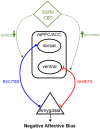The role of prefrontal-subcortical circuitry in negative bias in anxiety: Translational, developmental and treatment perspectives
- PMID: 30167466
- PMCID: PMC6097108
- DOI: 10.1177/2398212818774223
The role of prefrontal-subcortical circuitry in negative bias in anxiety: Translational, developmental and treatment perspectives
Abstract
Anxiety disorders are the most common cause of mental ill health in the developed world, but our understanding of symptoms and treatments is not presently grounded in knowledge of the underlying neurobiological mechanisms. In this review, we discuss accumulating work that points to a role for prefrontal-subcortical brain circuitry in driving a core psychological symptom of anxiety disorders - negative affective bias. Specifically, we point to converging work across humans and animal models, suggesting a reciprocal relationship between dorsal and ventral prefrontal-amygdala circuits in promoting and inhibiting negative bias, respectively. We discuss how the developmental trajectory of these circuits may lead to the onset of anxiety during adolescence and, moreover, how effective pharmacological and psychological treatments may serve to shift the balance of activity within this circuitry to ameliorate negative bias symptoms. Together, these findings may bring us closer to a mechanistic, neurobiological understanding of anxiety disorders and their treatment.
Keywords: Anxiety; circuit; negative bias; prefrontal cortex.
Conflict of interest statement
Declaration of conflicting interests: The author(s) declared no potential conflicts of interest with respect to the research, authorship and/or publication of this article.
Figures

Similar articles
-
The role of serotonin in the neurocircuitry of negative affective bias: serotonergic modulation of the dorsal medial prefrontal-amygdala 'aversive amplification' circuit.Neuroimage. 2013 Sep;78:217-23. doi: 10.1016/j.neuroimage.2013.03.075. Epub 2013 Apr 11. Neuroimage. 2013. PMID: 23583742 Free PMC article. Clinical Trial.
-
The translational neural circuitry of anxiety.J Neurol Neurosurg Psychiatry. 2019 Dec;90(12):1353-1360. doi: 10.1136/jnnp-2019-321400. Epub 2019 Jun 29. J Neurol Neurosurg Psychiatry. 2019. PMID: 31256001 Review.
-
Neurobiological Programming of Early Life Stress: Functional Development of Amygdala-Prefrontal Circuitry and Vulnerability for Stress-Related Psychopathology.Curr Top Behav Neurosci. 2018;38:117-136. doi: 10.1007/7854_2016_42. Curr Top Behav Neurosci. 2018. PMID: 28439771 Free PMC article.
-
A developmental shift from positive to negative connectivity in human amygdala-prefrontal circuitry.J Neurosci. 2013 Mar 6;33(10):4584-93. doi: 10.1523/JNEUROSCI.3446-12.2013. J Neurosci. 2013. PMID: 23467374 Free PMC article.
-
The role of corticolimbic circuitry in the development of anxiety disorders in children and adolescents.Curr Top Behav Neurosci. 2014;16:133-48. doi: 10.1007/7854_2013_242. Curr Top Behav Neurosci. 2014. PMID: 23950019 Review.
Cited by
-
Behavior in motivational conflicts is determined by magnitude of potential outcomes and relates to anxiety levels.Res Sq [Preprint]. 2025 Jun 24:rs.3.rs-6916454. doi: 10.21203/rs.3.rs-6916454/v1. Res Sq. 2025. PMID: 40678232 Free PMC article. Preprint.
-
The prefrontal cortex, pathological anxiety, and anxiety disorders.Neuropsychopharmacology. 2022 Jan;47(1):260-275. doi: 10.1038/s41386-021-01109-z. Epub 2021 Aug 16. Neuropsychopharmacology. 2022. PMID: 34400783 Free PMC article. Review.
-
Symptomatic Pathways of Comorbid Depression, Anxiety, and Stress Among Adolescents Exposed to Childhood Trauma-Insights from the Network Approach.Psychol Res Behav Manag. 2025 Mar 19;18:673-688. doi: 10.2147/PRBM.S492807. eCollection 2025. Psychol Res Behav Manag. 2025. PMID: 40123656 Free PMC article.
-
Nutritional Modulation of the Gut-Brain Axis: A Comprehensive Review of Dietary Interventions in Depression and Anxiety Management.Metabolites. 2024 Oct 14;14(10):549. doi: 10.3390/metabo14100549. Metabolites. 2024. PMID: 39452930 Free PMC article. Review.
-
Does non-invasive brain stimulation modulate emotional stress reactivity?Soc Cogn Affect Neurosci. 2020 Jan 30;15(1):23-51. doi: 10.1093/scan/nsaa011. Soc Cogn Affect Neurosci. 2020. PMID: 31993648 Free PMC article.
References
-
- Agustín-Pavón C, Braesicke K, Shiba Y, et al. (2012) Lesions of ventrolateral prefrontal or anterior orbitofrontal cortex in primates heighten negative emotion. Biological Psychiatry 72(4): 266–272. - PubMed
-
- Andersen SL. (2003) Trajectories of brain development: Point of vulnerability or window of opportunity? Neuroscience & Biobehavioral Reviews 27(1–2): 3–18. - PubMed
Grants and funding
LinkOut - more resources
Full Text Sources
Other Literature Sources

